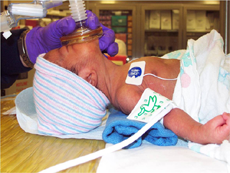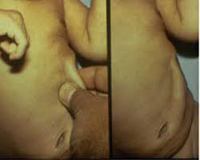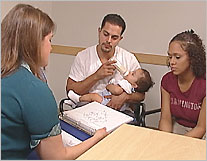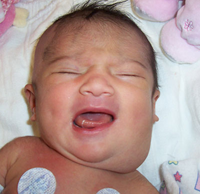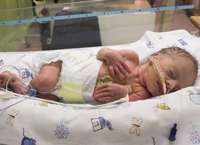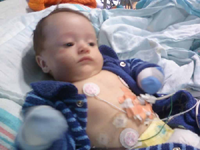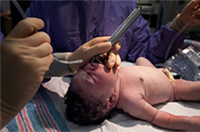| |
PAEDIATRIC FORMULAS |
|
 |
| |
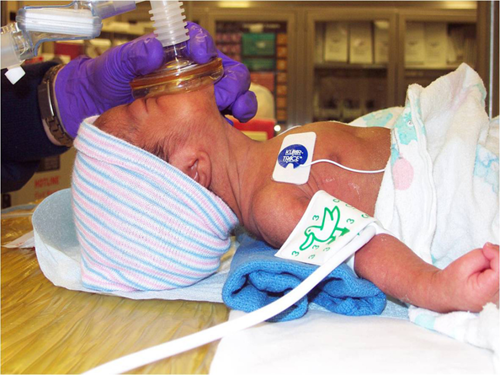 |
| |
Normal Physiological Variables |
| |
| Age |
BP (mmHg) |
HR (/min) |
RR (/min) |
Hct (%) |
| 1 kg |
45/30 |
120 - 180 |
|
40 - 50 |
| 2 kg |
55/35 |
110 - 180 |
|
40 - 50 |
| 3 kg |
65/40 |
100 - 180 |
40 - 60 |
45 - 65 |
| Neonate |
75/45 |
100 - 180 |
35 - 55 |
45 - 65 |
| 6 mo. |
85/50 |
80 - 180 |
30 - 50 |
30 - 40 (nadir) |
| 1 year |
95/55 |
80 - 130 |
20 - 30 |
34 - 42 |
| 10 year |
110/60 |
60 - 100 |
20 |
35 - 43 |
| Adult |
110/60 |
60 - 100 |
15 |
40 - 50 |
|
| |
Normal Urine Output |
| |
| Age (weeks) |
Urine Output (ml/h) |
| 20 |
5 cc/hr |
| 30 |
18 cc/hr |
| 40 |
50 cc/hr |
|
| |
Normal resting heart rates of infants and children |
| |
| | HEART RATE (beats/min) |
| Age |
Mean |
Range (±2 SDs) |
| 0 to 24 hr |
119 |
94 to 145 |
| 1 to 7 days |
133 |
100 to 175 |
| 8 to 30 days |
163 |
115 to 190 |
| 1 to 3 mo |
152 |
124 to 190 |
| 3 to 12 mo |
140 |
111 to 179 |
| 1 to 3 yr |
126 |
98 to 163 |
| 3 to 5 yr |
98 |
65 to 132 |
| 5 to 8 yr |
96 |
70 to 115 |
| 8 to 16 yr |
77 |
55 to 105 |
|
| |
Modified from Liebman J, Plonsey R, Gilette PC, editors: Pediatric electrocardiography. Baltimore, MD, 1982, Williams & Wilkins. |
| |
Age-Related Circulatory Variables |
| |
| Age |
Heart Rate (Beats/min) |
Systolic Blood Presssure (mm Hg) |
Diastolic Blood Pressure (mm Hg) |
Stroke Volume (mL/Beat) |
Cardiac Index (L/min/m2) |
Oxygen Consumption (mL/kg/min) |
Hemoglobin Concentration (g/dL) |
P50 (mm Hg) |
| Term newborn |
133 ± 18 |
80 ± 16 |
46 ± 16 |
4.5 ± 5.0 |
2.5 ± 0.6 |
6.0 ± 1.0 |
16.5 ± 1.5 |
18 |
| 6 mo |
120 ± 20 |
89 ± 29 |
60 ± 10 |
7.4 ± 2.0 |
2.0 ± 0.5 |
5.0 ± 0.9 |
11.5 ± 1.0 |
24 |
| 12 mo |
120 ± 20 |
96 ± 30 |
66 ± 25 |
11.5 ± 3.0 |
2.5 ± 0.6 |
5.2 ± 0.9 |
12.0 ± 0.75 |
— |
| 2 yr |
105 ± 25 |
99 ± 25 |
64 ± 25 |
16.9 ± 4.5 |
3.1 ± 0.7 |
6.4 ± 1.2 |
12.5 ± 0.5 |
27 |
| 5 yr |
90 ± 10 |
94 ± 14 |
55 ± 9 |
27.8 ± 7.5 |
3.7 ± 0.9 |
6.0 ± 1.1 |
12.5 ± 0.5 |
— |
| 12 yr |
70 ± 17 |
113 ± 18 |
59 ± 10 |
53.5 ± 14.5 |
4.3 ± 1.1 |
3.3 ± 0.6 |
13.5 ± 1.0 |
— |
| Adult |
75 ± 5 |
— |
— |
85.5 ± 6.0 |
3.7 ± 0.3 |
3.4 ± 0.6 |
14.0 ± 1.0 |
27 |
|
| |
Estimates of circulating blood volume |
| |
| Patient |
Blood Volume (mL/kg) |
| Premature newborn |
90 to 100 |
| Full-term newborn |
80 to 90 |
| 3 mo to 1 yr |
75 to 80 |
| 3 to 6 yr |
70 to 75 |
| >6 yr |
65 to 70 |
|
| |
Age-Dependent Respiratory Variables: Normal Values * |
| |
| |
Newborn |
6 mo |
12 mo |
3 yr |
5 yr |
12 yr |
Adult |
| Respiratory rate (breaths/min) |
50 ± 10 |
30 ± 5 |
24 ± 6 |
24 ± 6 |
23 ± 5 |
18 ± 5 |
12 ± 3 |
| Tidal volume (mL) |
21 |
45 |
78 |
112 |
270 |
480 |
575 |
| Minute ventilation (L/min) |
1.05 |
1.35 |
1.78 |
2.46 |
5.5 |
6.2 |
6.4 |
| Alveolar ventilation (mL/min) |
385 |
— |
1245 |
1760 |
1800 |
3000 |
3100 |
| Dead space–tidal volume ratio |
0.3 |
0.3 |
0.3 |
0.3 |
0.3 |
0.3 |
0.3 |
| Oxygen consumption (mL/kg/min) |
6 ± 1.0 |
5 ± 0.9 |
5.2 ± 0.9 |
± |
6.0 ± 1.1 |
3.3 ± 0.6 |
3.4 ± 0.6 |
| Vital capacity (mL) |
120 |
— |
— |
870 |
1160 |
3100 |
4000 |
| Functional residual capacity (mL) |
80 |
— |
— |
490 |
680 |
1970 |
3000 |
| Total lung capacity (mL) |
160 |
— |
— |
1100 |
1500 |
4000 |
6000 |
| Closing volume as a percentage of vital capacity |
— |
— |
— |
— |
20 |
8 |
4 |
| Number of alveoli (saccules) × 106 |
30 |
112 |
129 |
257 |
280 |
— |
300 |
| Specific compliance: CL/FRC (mL/cm H2O/L) |
0.04 |
0.038 |
— |
— |
0.06 |
— |
0.05 |
| Specific conductance of small airways (mL/sec/cm H2O/g) |
0.02 |
— |
3.1 |
1.7 |
0.12 |
8.2 |
13.4 |
| Hematocrit |
55 ± 7 |
37 ± 3 |
35 ± 2.5 |
40 ± 3 |
40 ± 2 |
42 ± 2 |
43-48 |
| pHa |
7.30 ± 7.40 |
— |
7.35-7.45 |
— |
— |
— |
7.35-7.45 |
| PaCO2 (mm Hg) |
30-35 |
— |
30-40 |
— |
— |
— |
30-40 |
| PaO2 (mm Hg) |
60-90 |
— |
80-100 |
— |
— |
— |
80-100 |
|
| |
From O’Rourke PP, Crone RK: The respiratory system. In Gregory G (ed): Pediatric Anesthesia, 2nd ed. New York, Churchill Livingstone, 1989, p 63. |
| |
CL, compliance of lung; FRC, functional residual capacity. |
| |
Fluid requirements |
| |
Fasting Guidelines for Pediatric Patients |
| |
| | Fasting Time (hr) |
| Age |
Milk and Solids |
Clear Liquids |
| <6 months |
4 |
2 |
| 6-36 months |
6 |
3 |
| >36 months |
8 |
3 |
|
| |
Maintenance Requirements in Children |
| |
| Weight (kg) |
Fasting Time (hr) Maintenance Requirements in Children
(mL/hour) |
| 0-10 |
4 (mL/kg) |
| 11-20 |
40 + 2 (mL/kg) |
| > 20 kg |
60 + 1 (mL/kg) |
|
| |
Replacement of Losses |
| |
| Procedure |
Insesnsible losses |
| Non-invasive (inguinal hernia, clubfoot) |
0-2 cc/kg/hr |
| Mildly invasive (uteteral reimplantation) |
2-4 cc/kg/hr |
| Moderately invasive (bowel reanastamosis) |
4-8 cc/kg/hr |
| Significantly invasive (NEC) |
> 10 cc/kg/hr |
|
| |
Intraoperative Glucose |
| |
Infants: 4 mg/kg/min = 240 mg/kg/hr maintenance requirements D5 = 50 mg/mL Delivery of D5 @ > 4 mL/kg/hr may lead to hyperglycemia |
| |
Catheter sizes and their flow rates |
| |
| |
|
MEAN FLOW RATE RANGE (mL/min) |
| Catheter Size (gauge) |
Length (inches) |
Crystalloid (gravity) |
Crystalloid (pressure) |
Blood (pressure) |
| 24 |
0.75 |
14 to 15 |
42 to 47 |
20 to 30 |
| 22 |
1 |
24 to 26 |
65 to 77 |
44 to 50 |
| 20 |
1.25 to 2 |
38 to 42 |
103 to 126 |
69 to 81 |
| 18 |
1.25 to 2 |
55 to 62 |
164 to 214 |
150 to 164 |
| 16 |
2 |
75 to 81 |
248 to 280 |
216 to 286 |
| 14 |
2 |
92 to 93 |
301 to 319 |
334 to 410 |
| 20 |
8 |
5 |
16 |
3 |
| 18 |
8 |
13 |
51 |
22 |
| 16 |
8 |
31 |
97 |
35 |
| Data summarized from Hodge D III, Fleisher G: Pediatric catheter flow rates. Am J Emerg Med 3:403, 1985. |
|
| |
Paediatric Airway Equipments |
| |
Pediatric Endotracheal Tube Size |
| |
| Age |
Internal Diameter (mm) |
Depth (cm) |
| Preterm |
2.5 |
6 - 8 |
| Term |
3.0 |
9 - 10 |
| 6 months |
3-3.5 |
10 |
| 1 - 2 years |
4.0 |
10 - 11 |
| 3 - 4 years |
4.5 |
12 - 13 |
| 5 - 6 years |
5.0 |
14 - 15 |
| 10 years |
6.0 |
16 - 17 |
|
| |
Pediatric Endotracheal Tube Depth |
| |
For preemies and neonates (cm) = weight (in kg) + 6 For 1 year or older (cm) = age + 10 cm
|
| |
Pediatric Airway Equipment |
| |
| Age |
Miller Blade |
| < 32 weeks |
00 |
| Term |
0 (< 3 kg) |
| 3-18 mo. |
1 (3-10 kg) |
| > 18 mo |
2 (> 12 kg) |
|
| |
Pediatric LMA Size |
| |
LMA sizes ~ weight (kg) / 20 + 1 (round to nearest 0.5)
|
| |
Laryngeal mask airway size characteristics |
| |
| Laryngeal Mask Airway Size |
Approximate Weight (kg) |
Cuff Volume (mL) |
| 1 |
<5 |
2 to 5 |
| 1.5 |
5 to 10 |
3 to 8 |
| 2 |
10 to 20 |
5 to 10 |
| 2.5 |
20 to 30 |
10 to 15 |
| 3 |
30 to 50 |
15 to 20 |
| 4 |
50 to 70 |
≤30 |
| 5 |
70 to 100 |
≤40 |
| 6 |
>100 |
≤50 |
|
| |
Pediatric-sized laryngeal mask airways and compatible endotracheal tubes[*] |
| |
| Laryngeal Mask Airway Size |
Maximum Lubricated Uncuffed Standard Endotracheal Tube Inner Diameter (mm) |
Maximum Lubricated Cuffed Standard Endotracheal Tube Inner Diameter (mm) |
Maximum Flexible Bronchoscope Size[†] |
| 1 |
3.5 |
3.0 |
2.7 |
| 1.5 |
4.0 |
4.0 |
3.0 |
| 2 |
5.0 |
4.5 |
3.5 |
| 2.5 |
6.0[‡] |
5.0 |
4.0 |
| 3 |
— |
6.0 |
5.0 |
| 4 |
— |
6.0 |
5.0 |
| 5 |
— |
7.0[†] |
5.0 |
| 6 |
— |
7.0[†] |
5.0 |
|
| |
Litman RS: The difficult pediatric airway. In Litman RS, editor: Pediatric anesthesia: The requisites, St. Louis, 2004, Mosby.
|
| |
*Based on experiments performed by the author.
|
| |
†As per LMA North America
|
| |
‡Largest available uncuffed endotracheal tube available at The Children's Hospital of Philadelphia.
|
| |
Laryngoscope blade types and sizes |
| |
| |
BLADE TYPE AND SIZE |
| Age |
Miller |
Wis-Hippel |
Macintosh |
| Premature neonate |
0 |
— |
— |
| Term neonate |
0 to 1 |
— |
— |
| 1 to 12 mo |
1 |
1 |
— |
| 1 to 2 yr |
1 |
1.5 |
2 |
| 2 to 6 yr |
2 |
— |
2 |
| 6 to 12 yr |
2 |
— |
3 |
|
| |
Endotracheal tube size[*] |
| |
| Age |
Weight (kg) |
ID (mm) |
Length (OT) (cm) |
Length (NT) (cm) |
Suction Catheter (F) |
| Premie |
0.7 to 1.0 |
2.5 |
7 to 8 |
9 |
5 |
| Premie |
1.0 to 2.5 |
3.0 |
8 to 9 |
9 to 10 |
5 |
| Newborn |
2.5 to 3.5 |
3.5 |
9 to 10 |
11 to 12 |
6 |
| 3 mo |
3.5 to 5.0 |
3.5 |
10 to 11 |
12 |
6 |
| 3 to 9 mo |
5.0 to 8.0 |
3.5 to 4.0 |
11 to 12 |
13 to 14 |
6 |
| 9 to 18 mo |
8.0 to 11.0 |
4.0 to 4.5 |
12 to 13 |
14 to 15 |
8 |
| 1.5 to 3 yr |
11.0 to 15.0 |
4.5 to 5.0 |
12 to 14 |
16 to 17 |
8 |
| 4 to 5 yr |
15.0 to 18.0 |
5.0 to 5.5 |
14 to 16 |
18 to 19 |
10 |
| 6 to 7 yr |
19.0 to 23.0 |
5.5 to 6.0 |
16 to 18 |
19 to 20 |
10 |
| 8 to 10 yr |
24.0 to 30.0 |
6.0 to 6.5 |
20 to 22 |
21 to 23 |
10 |
| 10 to 11 yr |
30.0 to 35.0 |
6.0 to 6.5[†] |
20 to 22 |
22 to 24 |
12 |
| 12 to 13 yr |
35.0 to 40.0 |
6.5 to 7.0[*] |
20 to 22 |
23 to 25 |
12 |
| 14 to 16 yr |
45.0 to 55.0 |
7.0 to 7.5[*] |
20 to 22 |
24 to 25 |
12 |
|
| |
Data modified from Smith RM: Anesthesia for infants and children. CV Mosby, 1980, St. Louis; Davenport HT: Paediatric anaesthesia. Year Book Medical Publishers, 1973, Chicago.
|
| |
ID, inner diameter; OT, orotracheal tube; NT, nasotracheal tube; F, French size (number is approximately equal to ID × 4).
|
| |
*The endotracheal tube should fit so as to allow full normal expansion of both lungs with positive airway pressure but to permit a gas leak about the tube at 20 to 25 cm H2O.
|
| |
† Cuffed tube
|
| |
Recommended nasotracheal tube dimensions |
| |
| |
TUBE LENGTH (L) (cm) |
| Age (yr) |
Tube Size (S) (ID, mm) |
Yates et al. (1987) |
Rees (1966) |
Steward (1979) |
| 0 to 3 mo |
2.5 to 3.0 |
9.5 to 11.0 |
11.8 |
13.5 |
| 4 to 7 mo |
3.5 to 4.0 |
12.5 to 14.0 |
13.6 |
|
| 1 |
4.0 |
14.0 |
14.5 |
15.0 |
| 2 |
4.5 15.5 |
15.2 |
16.0 |
|
| 3 |
4.5 to 5.0 |
15.5 to 17.0 |
15.6 |
|
| 4 |
5.0 |
17.0 |
16.5 |
17.0 |
| 5 |
5.0 to 5.5 |
17.0 to 18.5 |
16.8 |
|
| 6 |
5.5 |
18.5 |
17.1 |
19.0 |
| 7 |
5.5 to 6.0 |
18.5 to 20.0 |
17.8; |
|
| 8 |
6.0 |
20.0 |
18.3 |
21.0 |
| 9 |
6.0 to 6.5 |
20.0 to 21.5 |
18.8 |
|
| 10 |
6.5 |
21.0 |
19.1 |
22.0 |
| 11 |
6.5 to 7.0 |
21.5 to 23.0 |
19.1 |
|
| 12 |
7.0 |
23.0 |
|
22.0 |
|
| |
Medications for Children |
| |
Preoperative Medication in Children |
| |
|
| |
PO |
Nasal |
IV |
IM |
| Midazolam |
0.5 - 1.0 mg/kg |
|
0.05 - 0.10 mg/kg |
|
| Fentanyl |
|
|
1 - 3 ucg/kg |
|
| Morphine |
|
|
0.05 - 0.10 mg/kg |
|
| Sufentanil |
|
0.25 - 0.5 ucg/kg |
|
|
| Ketamine |
2-4 mg/kg |
|
|
4-6 mg/kg |
|
| |
Resuscitation Medication in Children |
| |
 |
Epinephrine = 10-100 ucg/kg for arrest (100 ucg/kg in ETT), 1-4 ucg/kg for hypotension |
 |
Atropine = 0.01 - 0.02 mg/kg (0.3 mg/kg in ETT) - actual dose 0.1 - 1 mg |
 |
Adenosine = 0.1 mg/kg (max dose 6 mg) |
 |
Lidocaine = 1-1.5 mg/kg |
 |
SCh = 2-3 mg/kg |
 |
Rocuronium 1 mg/kg |
 |
Calcium chloride = 10-20 mg/kg (dilute to 10 mg/cc or else veins will sclerose, try to give centrally if possible) |
 |
Bicarbonate = 1 mEq/kg (dilute to 1 mEq/cc or else veins will sclerose) |
 |
Naloxone = 0.1 mg/kg |
 |
DEFIBRILLATION = 2 J/kg (can increase up to 4 J/kg) |
|
| |
Preoperative Medication in Children |
| |
 |
Midazolam 0.05-0.1 mg/kg IV (0.5-1 mg/kg PO, 15 mg max) |
 |
Methohexital 1-2 mg/kg IV (25-30 mg/kg PR, 500 mg max) |
 |
Ketamine 1-2 mg/kg IV, 10 mg/kg IM, 5-8 mg/kg PO |
 |
Sodium Pentothal 1-2 mg/kg IV (separation), 4-6 mg/kg IV (induction) |
 |
Propofol 0.1-1 mg/kg IV (separation), 2-4 mg/kg IV (induction) |
 |
Etomidate 0.2-0.3 mg/kg IV |
|
| |
Antibiotic Doses in Children |
| |
 |
Cefazolin 25 mg/kg q6-8h up to 1-2 grams |
 |
Cefotaxime 20-30 mg/kg q6h |
 |
Ampicillin 50-100 mg/kg q6h up to 3 grams |
 |
Gentamicin 2-2.5 mg/kg q8h (must monitor serum levels, longer interval in renal impairment) |
 |
Clindamycin 5-10 mg/kg q6-8h up to 900mg |
 |
Mezlocillinn 50-100 mg/kg q6h up to 2g |
 |
Vancomycin 10 mg/kg q6h up to 1g |
|
| |
Other Useful Medication in Children |
| |
 |
Glycopyrrolate 0.01 mg/kg IV, IM, ETT (max 0.4 mg) |
 |
Morphine 0.05 - 0.1 mg/kg IV (max 0.4 mg/kg) |
 |
Fentanyl 1-5 ucg/kg IV |
 |
Ketorolac 0.5 mg/kg IV |
 |
Tylenol 20 mg/kg PO, 40 mg/kg PR |
 |
Zofran 0.05-0.15 mg/kg |
 |
Droperidol 20-25 ucg/kg |
 |
Dexamethasone 0.1-0.5 mg/kg for pain, N/V prophylaxis |
 |
Neostigmine 0.07 mg/kg |
 |
Dexamethasone 0.5-1 mg/kg for tracheal edema /td>
|
 |
Solumedrol 1 mg/kg IV |
|
| |
Characteristics of volatile anesthetics |
| |
| |
MAC (%) |
| |
Infant (1 to 6 mo) |
Child (3 to 10 yr) |
Adult |
| Halothane |
1.1 |
0.9 |
0.7 |
| Enflurane |
–– |
–– |
1.6 |
| Isoflurane |
1.7 |
1.6 |
1.2 |
| Desflurane |
9.4 |
8.0 |
6.0 |
| Sevoflurane |
3.3 |
2.5 |
2.0 |
|
| |
Adapted in part from Jones RM: Desflurane and sevoflurane; inhalation anesthetics for this decade? Br J Anaesth 65:527, 1990. Copyright © The Board of Management and Trustees of the British Journal of Anaesthesia. Reproduced by permission of Oxford University Press/British Journal of Anaesthesia.
|
| |
Intravenous dosage of opioids in children |
| |
| Drug |
As Major Anesthetic |
As Adjunct |
As Postoperative Analgesic |
| Morphine |
2 to 3 mg/kg |
0.05 to 0.1 mg/kg per hr |
0.05 to 0.1 mg/kg |
| Fentanyl |
50 to 100 mcg/kg |
1 to 3 mcg/kg per hr |
1 to 2 mcg/kg |
| Sufentanil |
10 to 15 mcg/kg |
0.1 to 0.3 mcg/kg per hr |
— |
| Alfentanil |
150 to 200 mcg/kg |
1 to 3 mcg/kg per min |
— |
| Remifentanil |
0.2 to 1.0 mcg/kg per min |
0.1 to 0.4 mcg/kg per min |
— |
| Hydromorphone |
5 to 10 mcg/kg |
3 to 5 mcg/kg per hr |
3 to 5 mcg/kg |
|
| |
Intravenous doses of muscle relaxants in children |
| |
| |
MAINTENANCE |
ED95 (mg/kg) |
| Drug |
Intubation (mg/kg) |
Bolus (mg/kg) |
Continuous |
Infusion (mcg/kg/m) |
Infants Children |
| Mivacurium |
0.2 to 0.3 |
0.1 |
10 to 20 |
0.1 |
0.1 |
| Cisatracurium |
0.15 |
0.1 |
1 to 5 |
0.05 |
0.05 |
| Vecuronium |
0.05 to 0.1 |
0.025 |
1 |
0.024 |
0.026 |
| Rocuronium |
0.8 to 1.0 |
0.3 to 0.5 |
15 |
0.2 |
0.3 |
| Pancuronium |
0.1 |
0.5 |
— |
0.05 |
0.05 |
| Pipecuronium |
0.1 |
— |
— |
0.035 |
0.05 |
|
| |
Nonsteroidal anti-inflammatory drugs (NSAIDs) |
| |
| Drug |
Age Group |
Dose (mg/kg) |
Interval |
| Acetaminophen |
Preterm Term |
Load: 20; 15(PO), 20 (PR) |
q12h |
| |
>3 mo |
Load: 20 to 30; 20 (PO) |
q8h |
| |
|
Load: 20 (PO); 15 (PO) |
q4h |
| |
|
40 (PR), 20 (PR) |
q6h |
| Diclofenac |
>1 yr |
1 (PO) |
q8h |
| Ibuprofen |
>6 mo |
10 to 15 (PO) |
q6h |
| Ketorolac |
>6 mo |
0.25 to 0.5 (IM, IV) |
q6h |
| Naproxen |
>6 mo |
5 to 10 (PO) |
q8–12h |
| Celecoxib |
>1 yr |
1.5 to 3 (PO) |
q12h |
|
| |
Opioid analgesics (μ-agonists) |
| |
| Drug |
Equipotent IV Dose (mg/kg) |
IV:PO Equivalence |
IV Dose (mg/kg) |
PO Dose (mg/kg) |
Interval (Minimum) |
Comments |
| Codeine |
1 |
1:1.5 |
NA |
0.5-1.0 |
q3h |
Usually prescribed with acetaminophen; limited analgesia in patients deficient in P450 2D6 isozyme |
| Fentanyl |
0.001 |
1:10 |
0.001 to 0.002 |
Transmucosal: 200-mcg unit smallest available; titrate to effective dose |
q1h (IV) |
Chest wall rigidity associated with doses >0.005 mg/kg; also available as transdermal system (12.5 to 100 mcg/hr delivery) for chronic pain neuraxial |
| Hydromor-phone |
0.02 |
1:5 |
0.015 to 0.02 |
0.1 |
q3h |
May cause less itching and nausea; no active metabolites; good in renal failure; neuraxial |
| Meperidine |
1.0 |
1:4 |
1.0 |
4 |
q3h |
Avoid monoamine oxidase inhibitors; normeperidine (metabolite) causes seizures; only short-term use |
| Methadone |
0.1 |
1:2 |
0.1 to 0.2 (load) |
0.1 to 0.2 |
q12h |
Very long-acting |
| Morphine |
0.1 |
1:3 |
0.1 |
0.3 |
q3h |
Histamine release; several slow-release oral forms available (MS Contin; Kadian; Avinza, Oramorph SR); neuraxial |
| Oxycodone |
0.2 |
|
|
0.1 to 0.2 |
q3h |
Little nausea or itch; slow-release oral form available (OxyContin); available in combination with acetaminophen or ibuprofen |
|
| |
Regional Anaesthesia |
| |
I. DOSES OF EPIDURAL ANALGESICS |
| |
Usual Doses and Infusion Regimens for Epidural Anesthesia in Pediatric Patients
|
| |
| Agent |
Initial Dose |
Continuous Infusion (Max. Doses) |
Repeat Injections |
| Bupivacaine, levobupivacaine |
Solution: 0.25% with 5 µg/mL (1/200,000) epinephrineDose:<20 kg: 0.75 mL/kg20-40 kg: 8-10 mL (or 0.1 mL/year/number of metameres)>40 kg: same as for adults |
<4 mo: 0.2 mg/kg/hr (0.15 mL/kg/hr of a 0.125% solution or 0.3 mL/kg/hr of a 0.0625% solution)4-18 mo: 0.25 mg/kg/hr (0.2 mL/kg/hr of a 0.125% solution or 0.4 mL/kg/hr of a 0.0625% solution)>18 mo: 0.3-0.375 mg/kg/hr (0.3 mL/kg/hr of a 0.125% solution or 0.6 mL/kg/hr of a 0.0625% solution |
0.1 to 0.3 mL/kg every 6-12 hr of a 0.25% or 0.125% solution (according to pain scores) |
| Ropivacaine |
Solution: 0.2% Dose: same regimen in mL/kg as for bupivacaine (see above) |
Same age-related infusion rates in mg/kg/hr as for bupivacaine (usual concentration of ropivacaine: 0.1%, 0.15%, or 0.2%) Do not infuse for more than 36 hr in infants < 3 mo |
0.1 to 0.3 mL/kg every 6-12 hr of a 0.15% or 0.2% solution (according to pain scores) |
| Adjuvants |
Avoid in infants < 6 moFentanyl (1-2 µg/kg) or sufentanil (0.1-0.6 µg/kg) or clonidine (1-2 µg/kg) |
Select only one additive:Fentanyl: 1-2 µg/mL
Sufentanil: 0.25-0.5 µg/mL
Morphine: 10 µg/mL
Hydromorphone: 1-3 µg/mL
Clonidine 0.3 at 1 µg/mL of solution |
Morphine (without preservatives): 25-30 µg/kg every 8 hr |
|
| |
Recommendations for dosing caudal and epidural blocks. |
| |
| |
Concentration |
Dose |
Possible Additives |
| Single-dose caudal |
0.175% to 0.5% |
0.75 to 1.25 mL/kg not to exceed 3 mng/kg |
Epinephrine 2.5 to 5 mcg/mL |
| Clonidine 1 to 2 mcg/kg |
| Morphine 30 to 70 mcg/kg |
| Continuous caudal or lumbar epidural catheters |
0.1% to 0.25% |
0.4 mL/kg per hr or 0.2 to 0.4 mg/kg per hr |
Fentanyl 2 to 5 mcg/mL |
| Hydromorphone 5 to 10 mcg/mL |
| Continuous thoracic epidural |
0.1% to 0.25% |
0.3 mL/kg per hr or 0.1 to 0.2 mg/kg per hr |
Fentanyl 2 to 5 mcg/mL |
| Hydromorphone 5 to 10 mcg/mL |
|
| |
Bupivacaine, levobupivacaine, or ropivacaine may be used. Greater concentrations and larger doses should be reserved for levobupivacaine or ropivacaine. Doses and concentrations should be reduced in infants. Children less than 2 years of age who receive morphine centrally require 24-hour monitoring after its delivery
|
| |
II. SPINAL ANAESTHESIA DOSES |
| |
Volumes of local anesthetic solutions for peripheral nerve blocks and regional anesthesia in children |
| |
| Block |
Volume (mL/kg) |
| Axillary |
0.2 to 0.5 |
| Interscalene |
0.33 |
| Sciatic |
0.15 to 0.2 |
| Femoral |
0.5 |
| Intravenous |
0.5 to 10 |
| Caudal |
0.5 to 1.0 |
| Intrapleural (infusion) |
0.5 (per hr) |
|
| |
Usual Doses of Local Anesthetics for Spinal Anesthesia in Neonates and Former Preterm Neonates Younger than 60 Weeks of Preconceptual Age (up to a Weight of 5 kg) |
| |
| Local Anesthetic |
Dose (mg/kg) |
Volume (mL/kg) |
Duration (min) |
| Tetracaine 1% |
0.4-1.0 |
0.04-0.1 |
60-75 |
| Tetracaine 1% with epinephrine |
0.4-1.0 |
0.04-0.1 |
90-120 |
| Bupivacaine 0.5% isobaric or hyperbaric |
0.5-1.0 |
0.1-0.2 |
65-75 |
| Levobupivacaine 0.5% |
0.1 |
0.2 |
75-88 |
| Ropivacaine 0.5% |
1.08 |
0.22 |
51-68 |
|
| |
Usual Doses of Local Anesthetics for Spinal Anesthesia in Children and Adolescents |
| |
| Local Anesthetic |
Usual Dose(s) |
| 0.5% Isobaric or hyperbaric bupivacaine |
5 to 15 kg: 0.4 mg/kg (0.08 mL/kg)
>15 kg: 0.3 mg/kg (0.06 mL/kg) |
| 0.5% Isobaric or hyperbaric tetracaine |
5 to 15 kg: 0.4 mg/kg (0.08 mL/kg)
>15 kg: 0.3 mg/kg (0.06 mL/kg) |
| 0.5% Isobaric levobupivacaine |
5 to 15 kg: 0.4 mg/kg (0.08 mL/kg)
15-40 kg: 0.3 mg/kg (0.06 mL/kg)
>40 kg: 0.25 mg/kg (0.05 mL/kg) |
| 0.5% Isobaric ropivacaine |
0.5 mg/kg (max 20 mg) |
|
| |
III. RECOMMENDATIONS FOR DOSING OF PERIPHERAL NERVE BLOCKS |
| |
Recommended Volumes of Local Anesthetic for Single-Shot Upper Limb Blocks with Neurostimulation by Patient Weight |
| |
| |
Patient Weight |
Conduction Block |
≤10 kg |
11-30 kg |
31-60 kg |
>60 kg |
Brachial plexus above clavicle |
1 mL/kg |
10 mL + 0.5 mL/kg above 10 kg |
20 mL + 0.25 mL/kg above 30 kg |
30 mL |
Brachial plexus below clavicle |
0.5 mL/kg |
5 mL + 0.25 mL/kg above 10 kg |
10 mL + 0.15 mL/kg above 30 kg |
15 mL |
Any nerve trunk at elbow |
0.2 mL/kg |
0.15 mL/kg |
0.15 mL |
10 mL |
Any nerve trunk at wrist |
0.05 mL/kg |
0.05 mL/kg |
0.05 mL/kg |
3-5 mL |
|
| |
Recommended Volumes of Local Anesthetic for Single-Shot Lower Limb Blocks with Neurostimulation |
| |
Conduction Block |
≤10 kg |
11-30 kg |
31-60 kg |
>60 kg |
Lumbar plexus (psoas compartment) |
1 mL/kg |
10 mL + 0.5 mL/kg above 10 kg |
20 mL |
20 mL |
Femoral |
0.5 mL/kg |
5 mL + 0.35 mL/kg above 10 kg |
12 mL + 0.3 mL/kg above 30 kg |
25 mL |
Fascia iliaca |
1 mL/kg |
10 mL + 0.5 mL/kg above 10 kg |
20 mL + 0.25 mL/kg above 30 kg |
30 mL |
Proximal sciatic |
1 mL/kg |
10 mL + 0.5 mL/kg above 10 kg |
20 mL + 0.3 mL/kg above 30 kg |
30 mL |
Sciatic in popliteal fossa |
0.3 mL/kg |
3 mL + 0.2 mL/kg above 10 kg |
6 mL + 0.15 mL/kg |
12.5 mL |
|
| |
Usual Local Anesthetic Infusion Rates with or without Bolus Doses of Either Ropivacaine 0.2%, Bupivacaine 0.125%, or Levobupivacaine 0.15% to 0.2% for Continuous Peripheral Nerve Blocks |
| |
Techniques |
Plexus and Proximal Conduction Nerve Blocks * |
Axillary and Popliteal Blocks |
Infusion rate |
0.2 mL/kg/hr up to 10 mL/hr |
0.1 mL/kg/hr up to 5 mL/hr |
Bolus doses |
0.2 mL/kg up to 5 mL |
0.1 mL/kg/hr up to 3 mL/hr |
Maximum bolus doses per hour |
3 |
3 |
|
| |
Regional Technique |
Bolus Dose (mLμ/kg)[*] |
Continuous Infusion (mLμ/kg per hr) |
Axillary Parascalene |
0.2 to 0.5 0.2 to 0.4 |
0.1 to 0.2 0.1 to 0.2 |
Femoral or lateral femoral cutaneous |
0.3 to 1 |
0.15 to 0.3 |
Fascia iliaca |
0.5 to 1 |
0.15 to 0.3 |
Lumbar plexus |
0.5 to 1 |
0.15 to 0.3 |
Sciatic |
0.3 to 1 |
0.15 to 0.3 |
Ilioinguinal/iliohypogastric |
0.25 |
NA |
Penile block |
0.1 |
NA |
Paravertebral |
0.5 |
0.2 to 0.25 |
|
| |
NA, not applicable.
|
| |
Bupivacaine, levobupivacaine, or ropivacaine may be used. For bolus dosing, lower concentrations such as 0.2% to 0.25% should be used in infants and young children, whereas concentrations of 0.375% to 0.5% should be used in children >5 to 8 years of age. For continuous infusions, lower concentrations such as 0.1% to 0.2% of all agents are acceptable
|
| |
References : |
| |
1.SMITH'S Anesthesia for Infants and Children, Seventh Edition. |
| |
2.Miller's Anesthesia - 7th ed. |
| |
Download Paediatric Anaesthesia Pocket Reference |
| |
Quiz in Paediatric Anaesthesia |






